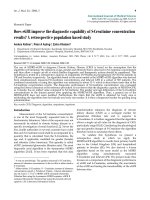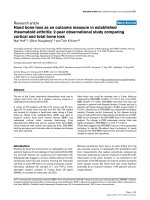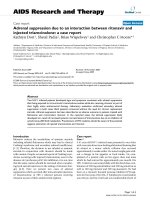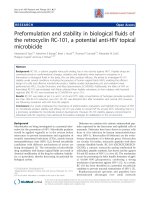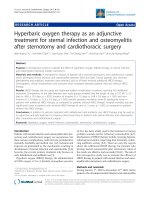Báo cáo y học: "Neonatal retroauricular cellulitis as an indicator of group B streptococcal bacteremia: a case report" ppt
Bạn đang xem bản rút gọn của tài liệu. Xem và tải ngay bản đầy đủ của tài liệu tại đây (334.7 KB, 3 trang )
BioMed Central
Page 1 of 3
(page number not for citation purposes)
Journal of Medical Case Reports
Open Access
Case report
Neonatal retroauricular cellulitis as an indicator of group B
streptococcal bacteremia: a case report
David Pérez Solís*, Juan José Díaz Martín and Etelvina Suárez Menéndez
Address: Department of Pediatrics, Hospital San Agustín, Camino de Heros, 4 33400 Avilés, Spain
Email: David Pérez Solís* - ; Juan José Díaz Martín - ; Etelvina Suárez
Menéndez -
* Corresponding author
Abstract
Introduction: The relation between cellulitis and Group B streptococcus infection in newborns
and small infants was first reported during the early 1980s and named cellulitis-adenitis syndrome.
We report a case of a neonate with cellulitis-adenitis syndrome in an unusual location
(retroauricular).
Case presentation: A 21-day-old Caucasian female infant was brought to the emergency
department with fever, irritability and a decreased appetite. Physical examination revealed
erythema and painful, mild swelling in the right retroauricular region. The blood count and C-
reactive protein level were normal. She was treated with ceftriaxone. The fever and irritability
were resolved after 24 hours, and the cellulitis was clearly reduced after two days of
hospitalization. Blood culture yielded Group B streptococcus.
Conclusion: A thorough evaluation must be done, and lumbar punctures for infants with cellulitis
must be considered. We emphasize the lack of data about acute phase reactants to predict
bacteremia and meningitis and to adjust the duration of parenteral antibiotic therapy to address
this syndrome.
Introduction
Group B streptococcus (GBS, Streptococcus agalactiae) is
usually related to early onset neonatal sepsis, but it is also
a cause of infection in neonates aged more than one week.
The late onset of GBS infections normally manifest as sep-
sis, meningitis or, less frequently, focal infection [1].
The relation between cellulitis with or without regional
lymphadenitis and GBS infections in newborns and
small infants was first reported during the early 1980s. It
was then named cellulitis-adenitis syndrome [2-4]. Cases
described in the literature since then not only suggest that
GBS bacteremia is common, but that meningeal involve-
ment is also frequent [5]. Cellulitis is mostly located in the
submandibular and preauricular area of the head [2]. We
report the case of a neonate with retroauricular cellulitis
without lymphadenitis. The results reveal that the neonate
had GBS bacteremia.
Case presentation
A 21-day-old Caucasian female infant from Spain was
brought to our emergency department with a fever, irrita-
bility, and decreased appetite for six hours. She was born
through vaginal delivery after 39 weeks of uncomplicated
gestation. A vaginal culture of GBS was negative. The
infant was bottle-fed since birth.
Published: 16 December 2009
Journal of Medical Case Reports 2009, 3:9334 doi:10.1186/1752-1947-3-9334
Received: 12 October 2009
Accepted: 16 December 2009
This article is available from: />© 2009 Pérez Solís et al; licensee BioMed Central Ltd.
This is an Open Access article distributed under the terms of the Creative Commons Attribution License ( />),
which permits unrestricted use, distribution, and reproduction in any medium, provided the original work is properly cited.
Journal of Medical Case Reports 2009, 3:9334 />Page 2 of 3
(page number not for citation purposes)
The physical examination revealed that the infant had a
fever (rectal temperature of 39.1°C) with erythema and
painful but mild swelling in the right retroauricular region
(Figure 1). The blood count revealed 5800 leukocytes/
mm
3
(46% polymorphonuclear neutrophils and 1%
bands), and hemoglobin 13.3 g/dL; the C-reactive protein
level (CRP) was 5 mg/L; and the serum glucose and elec-
trolytes, as well as urinalysis, were normal. A lumbar
puncture was not performed.
She was admitted and treated empirically with ceftriaxone
(75 mg/kg/day). The fever and irritability were resolved
after 24 hours, and the cellulitis clearly improved after two
days of hospitalization. Three days after admission, the
blood culture yielded GBS. The infant was discharged after
five days of treatment with ceftriaxone. Then, antibiotic
therapy was continued with oral cephuroxime for the next
seven days. An outpatient visit two weeks after discharge
revealed no sequelae.
Discussion
Late onset GBS infections usually occur between the ages
of one week and three months. But, in up to one out of
five cases, GBS infections may occur in infants older than
three months of age [1].
In 1982, Baker [2] discussed GBS cellulitis-adenitis syn-
drome based on her own experience as well as that of
other previously reported patients (a total of 16 cases).
Her study showed that infants from two to 10 weeks of
age suffer from a typical but abrupt onset of a fever, as well
as poor feeding and/or irritability. Cellulitis was predom-
inantly located in the submandibular region. But, in iso-
lated cases, cellulitis was found in preauricular, cervical,
genian, or inguinal regions. Adenitis was present in each
infant with submandibular cellulitis. In 15 out of 16
patients, GBS bacteremia was present upon admission.
Since then, some new cases with very similar features have
been reported in the literature [6-12].
It has been suggested that subcutaneous infection is sec-
ondary to GBS bacteremia in infants with a previous skin
or mucous colonization. Probably, certain subcutaneous
areas are predisposed to becoming metastatic sites of
infection. Another hypothesis is that bacteremia is sec-
ondary to a primary focus and lymphatic spread [2,3].
GBS cellulitis-adenitis syndrome is relevant because it is
often associated with bacteremia and meningitis (91%
and 24% of cases, respectively, according to a recent
review [5]). Meningitis has been found even in infants in
good clinical condition and with no clinical signs of cen-
tral nervous system infection. Routine use of lumbar
punctures is usually recommended in small infants with
cellulitis-adenitis syndrome [5]. However, it must be
noted that these are only isolated clinical cases. These inci-
dences must not be overvalued, since published clinical
cases are usually the most severe ones. It is more probable
that lumbar punctures are performed on infants with
worse clinical conditions. On the other hand, there is no
data about the value of diagnostic tests (white blood cell
count, C-reactive protein, procalcitonin, etc.) to predict
bacteremia or meningitis in newborns and small infants
with cellulitis. As a lumbar puncture was not performed
on our patient, it is not possible for us to definitely rule
out meningitis.
Antimicrobial therapy in patients with cellulitis-adenitis
syndrome traditionally includes parenteral antibiotics for
10 to 14 days. Nowadays, the duration of the antimicro-
bial therapy may be guided by clinical and patient
responses to acute phase reactants (especially C-reactive
protein) [13].
Conclusion
In our case, we emphasize the absence of adenitis in the
retroauricular location even though our patient had GBS
bacteremia, as with most cellulitis-adenitis cases. We con-
clude that for any newborn or small infant with cellulitis,
a thorough evaluation must be done regardless of clinical
condition. A lumbar puncture must also be considered. It
would be interesting to have available studies on the glo-
bal incidence of GBS bacteremia and meningitis in cellu-
litis-adenitis syndrome, as well as on the value of acute
phase reactants to predict them and to adjust the duration
of parenteral antibiotic therapy.
Abbreviations
CRP: C-reactive protein; GBS: Group B streptococcus.
Erythema and swelling in the right retroauricular regionFigure 1
Erythema and swelling in the right retroauricular
region.
Publish with BioMed Central and every
scientist can read your work free of charge
"BioMed Central will be the most significant development for
disseminating the results of biomedical research in our lifetime."
Sir Paul Nurse, Cancer Research UK
Your research papers will be:
available free of charge to the entire biomedical community
peer reviewed and published immediately upon acceptance
cited in PubMed and archived on PubMed Central
yours — you keep the copyright
Submit your manuscript here:
/>BioMedcentral
Journal of Medical Case Reports 2009, 3:9334 />Page 3 of 3
(page number not for citation purposes)
Consent
Written informed parental consent was obtained for both
print and online publication of this case and any accom-
panying images. A copy of the written consent is available
for review by the Editor-in-Chief of this journal.
Competing interests
The authors declare that they have no competing interests.
Authors' contributions
DPS was a major contributor in writing the manuscript
and preparing the literature review. JJDM and ESM inter-
preted the patient data and were contributors in writing
the manuscript. All authors read and approved the final
manuscript.
References
1. Yagupsky P, Menegus MA, Powell KR: The changing spectrum of
group B streptococcal disease in infants: an eleven-year
experience in a tertiary care hospital. Pediatr Infect Dis J 1991,
10:801-808.
2. Baker CJ: Group B streptococcal cellulitis-adenitis in infants.
Am J Dis Child 1982, 136:631-633.
3. Hauger SB: Facial cellulitis: an early indicator of group B strep-
tococcal bacteremia. Pediatrics 1981, 67:376-377.
4. Patamasucon P, Siegel JD, McCracken GH Jr: Streptococcal sub-
mandibular cellulitis in young infants. Pediatrics 1981,
67:378-380.
5. Albanyan EA, Baker CJ: Is lumbar puncture necessary to
exclude meningitis in neonates and young infants: lessons
from the group B streptococcus cellulitis- adenitis syn-
drome. Pediatrics 1998, 102:985-986.
6. Artigas Rodríguez S, Díaz González P, Domingo Garau A, Casano San-
cho P, Juma K, Caritg Bosch J: Síndrome adenitis-celulitis por
estreptococo del grupo B en lactantes. Un indicador de bac-
teriemia. An Esp Pediatr 2002, 56:251-252.
7. Barton LL, Ramsey RA, Raval DS: Neonatal group B streptococ-
cal cellulitis-adenitis. Pediatr Dermatol 1993, 10:58-60.
8. Bustos R: Síndrome adenitis-celulitis: Una presentación infre-
cuente de infección tardía por streptococcus agalactiae.
Revista chilena de pediatría 2004, 75:455-458.
9. Chakkarapani E, Yoxall C, Morgan C: Facial submandibular cellu-
litis-adenitis in a preterm infant. Archives of Disease in Childhood
- Fetal and Neonatal Edition 2007, 92:F153.
10. Mittal MK, Shah SS, Friedlaender EY: Group B streptococcal cel-
lulitis in infancy. Pediatr Emerg Care 2007, 23:324-325.
11. Rathore MH: Group B streptococcal cellulitis and adenitis con-
current with meningitis. Clin Pediatr (Phila) 1989, 28:411.
12. Soler Palacín P, Monfort Gil R, Castells Vilella L, Pagone Tangorra F,
Creixams X, Balcells Ramírez J: Síndrome de celulitis-adenitis
por estreptococo del grupo B como presentación de sepsis
neonatal tardía. An Pediatr (Barc)
2004, 60:75-79.
13. Ehl S, Gering B, Bartmann P, Hogel J, Pohlandt F: C-reactive protein
is a useful marker for guiding duration of antibiotic therapy
in suspected neonatal bacterial infection. Pediatrics 1997,
99:216-221.


